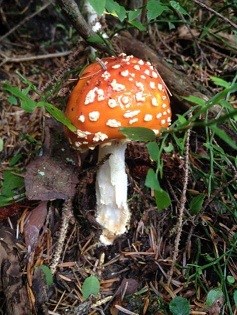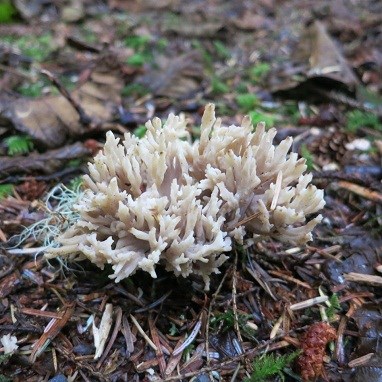|
Organisms of the fungi kingdom are critically important to forest ecosystems. Fungi break down organic matter, and are the only organisms capable of breaking down lignin, an organic polymer compound in wood. Some fungi directly consume and decompose matter such as wood, leaf litter, and other plant material. Other fungi are parasites on plants, animals, or other fungi. Still others form symbiotic associations with other organisms, particularly plants. Fungi are the most diverse group of organisms after insects in terms of species and ecological functions. The park's temperate rainforest habitat is great for fungi, so a rich diversity can be found within the park. 
NPS/ Charlie Jones The most easily observable fungi in the park (and arguably the most interesting to people) are mushrooms. Mushrooms are the fruiting bodies of certain species of fungi used to distribute spores, which are the reproductive units of a fungus. They come in many different shapes, forms, colors, and sizes. Typically, mushrooms are most abundant in the park during late summer and fall, when spore distribution and subsequent fungal growth can benefit from fallen leaves and needles, and a cover of snow. Collecting or harvesting mushrooms in the park is NOT allowed (36 CFR 2.1(a)(1)(ii)). There are other areas around Sitka where harvesting mushrooms is permitted, such as the Tongass National Forest. The information below is intended only as a basic introductory guide, and should NOT be used as the sole resource for mushroom identification. Some great resources on mushrooms are listed at the conclusion of this article. 
NPS / Charlie Jones Basic facts about the main types of mushrooms are summarized below. For more detailed information and photos of some of the wonderful mushrooms that can be found in the park, visit the mushroom picture gallery.
Gilled Mushrooms Gilled mushrooms typically have a stem and a cap with plate-like gills on the underside. These gills are responsible for the storage and disposal of reproductive spores. There are many different types of gilled mushrooms. While these mushrooms are typically what first comes to mind when thinking about mushrooms, there are many other weird and wonderful types that are of interest to the mushroom enthusiast.
Chanterelles Chanterelles bear their spores on folds on the underside of the cap rather than on true gills. They still have a cap and stalk, though there may often be little distinction between them. They vary widely in size and are usually vase, funnel, or trumpet shaped. There are two main types of chanterelles found in the park –winter chanterelles and golden chanterelles.
Spine mushrooms Spine fungi produce their spores on downward hanging spines rather than on gills.
Polypores Polypores produce their spores inside closely packed tubes. They usually have no stalk and are tough, fibrous, leathery, or woody. Many fruit from logs, stumps and snags and form single or multiple, small to large shelf-like caps.
Coral and Club fungi Coral and club fungi are a diverse group, which bear their spores on upright clubs or branches of coral-like bodies.
ReferencesSome great resources are available to learn more about mushrooms, mushroom identification, and mushroom poisoning.
Books Arora, David. Mushrooms Demystified. Berkeley: Ten Speed Press, 1986.
Guild, Ben. The Alaskan Mushroom Hunter's Guide. Anchorage: Alaska Northwest Publishing Company, 1977.
Trudell, Steve, and Joseph F. Ammirati. Mushrooms of the Pacific Northwest. Portland, OR: Timber Press, 2009.
Web Resources Mushrooms of the National Forests of Alaska, USFS. Available from: https://www.fs.usda.gov/Internet/FSE_DOCUMENTS/stelprdb5414170.pdf
North American Mycological Association: www.namyco.org
Photo Gallery |
Last updated: September 28, 2021
